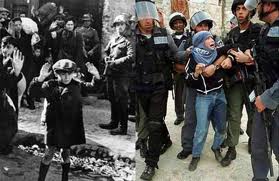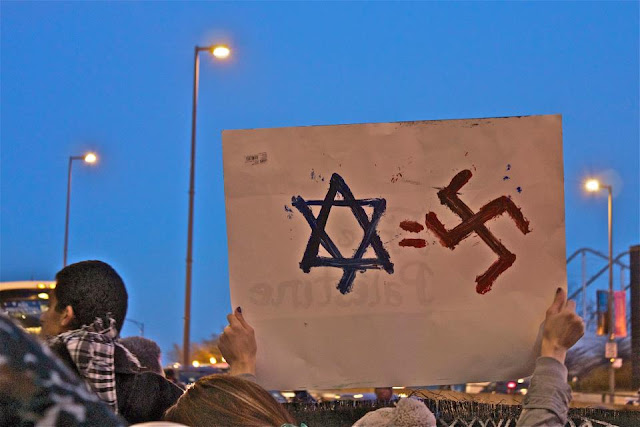By Miri –
In response to Israel’s last assault on Gaza, demonstrations and rallies swept across the streets of many cities all over the world, and slogans in solidarity with Gaza filled social networking and media sides. Although I welcomed and agreed with the protests, some of the pictures and lines of discourse disconcerted me. As usual I was particularly disturbed by the images of placards with swastikas superimposed on the Israeli flag or worse, the Star of David, or the proliferation of equations of Gaza with the Warsaw Ghetto.
 |
| Famous image from the Warsaw Ghetto, Jews are being rounded up in April 1943 before being deported to the Treblinka death camp where 300,000 were murdered, juxtaposed with a Palestinian boy being detained by Israeli soldiers. |
Obviously, using the Nazi analogy is a very potent discursive strategy since “anything associated with the Nazis is condemned with unconditional moral indignation in most contemporary Western societies”.
One of our main goals at Green Olive Tours is to point out the complexity of the situation in Palestine and Israel. We therefore avoid using generalisations which represent Israelis and Palestinians as homogeneous entities and therefore also strongly condemn comparisons between Nazi Germany and Israel as simplistic and historically inadequate. We would further like to emphasise that such a comparison is essentially unproductive for the Palestinian cause and can further have severe consequences which unfortunately also amount to anti-Semitic acts and the slandering of the memory of victims and survivors of the Holocaust, both Jewish and non-Jewish.
Many evils were committed throughout human history, and some of those events exceeded the Holocaust in terms of the number of deaths involved, yet many historians and other scholars claim that the Holocaust committed by Nazi Germany and its allies was an unparalleled event and is therefore beyond comparison. Kundnani persuasively points to three features of the Holocaust which, taken together, make it unique. The first one is the scale of the killing: six million Jews and countless others were executed due to their religion, ethnicity, physical ability, sexual orientation, and political perspective, which brings us to the second feature: the motivation for the killing. Jews were exterminated because they were Jews, Sinti and Roma were executed because they were Sinti and Roma etc.. Finally the method, millions of people were killed in an industrialised way, in death factories, which were pretty unprecedented in history. Kundnani continues that according to his knowledge there is no event “anywhere in the world at any time in history that possesses this combination of scale, motivation and method – in other words, an industrialised genocide on the scale of the Holocaust.”
 |
| Cartoon by Carlos Latuff, depicting former Israeli Prime Minister Ariel Sharon kissing Adolf Hitler |
But let’s take those three features and apply them to Israel and its treatment of the Palestinian population.
1) Scale of the Killing
It is admittedly difficult, if not impossible, to find a reliable source for the total death toll of Palestinians since the origin of the conflict at around 1917, the year of the issuing of the Balfour Declaration, which affirmed British support for the establishment of a Jewish national home in Mandate Palestine, and which thus constitutes the starting point of increasing tensions between the local Palestinian population and the Zionist movement. The notion of finding an accurate number is further complicated by the fact that third parties, such as the British and numerous other Arab states have been involved in the conflict since its onset, and that there has also been a considerable number of fatalities due to intra-Palestinian violence.
According to Heinsohn, the conflict between Israelis and Palestinians has caused 51,000 deaths between 1950 and 2006, 35,000 of who were Palestinians. While the numbers to date should be considerably higher and probably more uneven, with a disproportionately higher number of Palestinian fatalities, it is safe to say that it will still be far below 100,000.
2) Motivation
In the aftermath of the Holocaust, the United Nations adopted the Convention on the Prevention and Punishment of the Crime of Genocide (CPPCG), which legally defined the term genocide and affirmed it as a crime under international law. Article 2 of said Convention defines genocide as
“any of the following acts committed with intent to destroy, in whole or in part, a national, ethnical, racial or religious group, as such:
a) Killing members of the group;
b) Causing serious bodily or mental harm to members of the group
c) Deliberately inflicting on the group conditions of life calculated to bring about its physical destruction in whole or in part;
d) Imposing measures intended to prevent births within the group;
e) Forcibly transferring children of the group to another group.”
Since the CPPCG came into effect there have been a number of disagreements concerning its interpretation. Legal scholars, as well as genocide scholars have been debating whether the “intent to destroy” a group should be understood exclusively as the physical-biological destruction of the group, or whether a more broader view of intentional destruction of societies or groups through violence and coercion of various kinds should be considered. Those advocating the latter view would also consider intentional mass displacements of populations, i.e. ethnic cleansing, such as experienced by 700,000 Palestinians in 1948, as genocide.
Whether or not the Palestinian experience can be defined as an attempted genocide seems thus to be a matter of interpretation of the term. Yet even those scholars who do support the equation of ethnic cleansing with genocide are not contending that Israel ever had the plan to destroy the Palestinian society as a whole. Both in 1948, as well as today, the main motivation behind Israeli policies must be seen as extending Israeli control over as much territory as possible, and as some like Israeli sociologist Baruch Kimmerlin argue, to make the creation of a viable Palestinian state all but impossible to achieve, a notion that he has labelled “politicide”. While racism is definitely on the rise, including within the Israeli government, Israeli policies yielding at the confiscation of Palestinian land and the concomitant displacement of the Palestinian population can by no means be equated with Hitler’s “final solution of the Jewish question”, which aimed at the annihilation of the Jewish people as a whole.
3) Methods:
There can be no question that, although Israel is continuously violating the basic rights of Palestinians, including killing and illegitimately incarcerating them, their methods can by no means be compared to those of the Nazis and their concentration camps, which were built in order to confine Jews into the smallest possible space, eventually in preparation for their ultimate extinction. Millions of people were systematically killed by gassing and extreme work under starvation conditions.
We can thus conclude that comparisons between Israel and Germany’s Third Reich are historically unfounded and mainly serve to simplify the complexity of both situations.
 |
| Placard seen in a demonstration in solidaity with Gaza, Chicago, November 2012 |
Whether or not the playing of the Nazi card against Israel and Zionism in itself amounts to anti-Semitism is also very much disputed. Those Jews who view Israel and Zionism as central to the Jewish identity will unquestionably regard such a move as anti-Semitic, those who define their identity in different ways may feel differently. At the same time it also very much depends on the nature of the comparison. The above illustrated equation of a swastika with a Star of David, a symbol that, although it is also used in the Israeli flag, represents Jewry as a whole, clearly constitutes an anti-Semitic act, even if it was intended to criticise the Jewish state only. It is thus, as Iganski and Sweiry write, “neither useful nor necessary to try to get inside the heads of those who use such discourse […] to determine whether antisemtic bias is at work, it is the consequences of the words [or imagery] they use that matter.”
The fact that the Nazi card is disproportionately more often played against Israel than at any other state points to other implications of the historically inadequate comparison, namely at a double standard that criticises Israel’s actions much harsher than that of other states, as well as an intentional reversion of roles in which the Jews as victims of Nazism are being transformed into Nazis themselves. Notice that here again the emphasis lies on Jews as a global community and not on Israel and its policies towards Palestinians.
While there is no question that the Holocaust has and continues to be shamelessly instrumentalised by the Israeli state and its supporters themselves, the real pain and trauma that it has caused to millions of people could not be alleviated. Thus using and relativising the Holocaust also affects and slanders the memories of those who have been victimised by it, and whose lives may not be connected to the state of Israel and its policies towards the Palestinians at all.
In line with this is also the often heard argument that as a people who underwent an attempted genocide themselves, Jews are expected to conduct themselves better than other nations. This naïve and morally dubious expectation completely ignores the fact that mass expulsions and killings were unfortunately still commonplace after the end of WWII and begs the question of why the atrocities committed by Jews after the Holocaust are considered to be more sickening than those committed by people who did not undergo mass murder.
The fact that the suffering endured by Palestinians is not comparable in scope to the Holocaust, or other genocides, such as in Rwanda or Bosnia, does not diminish it. There is plenty to criticise about the policies, practices and leaders of the Israeli state and protest can be expressed in numerous forceful and much more adequate and productive ways.
Marc Levine emphasises that also for the Palestinian cause it is crucial to provide an accurate historical context to the current conflict. “[T]he use of highly charged historical comparisons that do not hold up to scrutiny unnecessarily weaken the Palestinian case against the occupation”. Furthermore, “handing Israel’s supporters the gift of inaccurate or exaggerated comparisons does not help this struggle, particularly not in Israel and the US, the two most important battlegrounds in this conflict.“
For a more thorough analysis on the significance of the Holocaust in Israeli society and as a response to this article, read on here





Comment (0)